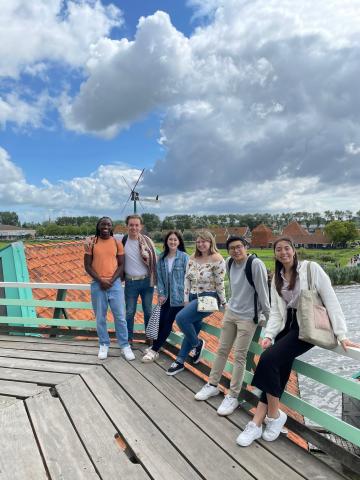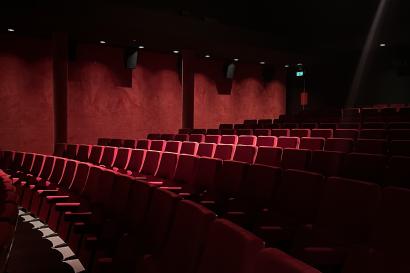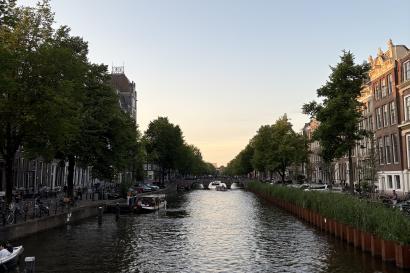For me, the greatest burden and barrier to studying abroad was financial. Paying tuition, navigating scholarships, applying to loans—it’s a lot to manage. Once you get through all the hurdles, you might be left wondering how much you need to have saved to survive abroad.
I come from a family background where money was always the prevailing factor for whether or not opportunities were feasible. Even now, I actively consider the finances behind every move I make to decide whether I’m being smart with my money.
So maybe you’re like me, or maybe you’re not. Either way, part of studying abroad requires some level of money management. Before you know where and how to save, you have to understand where your money is going. I’m here to share my experiences with where I’ve spent the most, and I’ll provide some general resources I rely on for tips, tricks, and hacks. Within that, I’ll give some more Amsterdam-specific advice about where to turn.
1. Clothing
Perhaps my favorite part of Europe has been exploring the outdoor street markets. You can find them all over Amsterdam, and they’re a great resource to search for all the basics at a decent price point. I almost strictly shop at markets now. Here’s why:
Back in the U.S. I only shopped secondhand at places like Goodwill and Plato’s Closet. Sadly, you won’t find those brands here. Most secondhand shops are quality vintage, so they tend to be priced higher than what you’d see around Goodwill. Don’t get me wrong, the price matches the quality, but when you’re budgeting, the cost of even two shirts can be hefty.

It’s worth exploring the vintage vibes because some of my best finds were in adorable shops hidden throughout the city. But now, I take to the common textile markets, like in Westermarkt, where they have many fabrics for sale as well as mounds of clothes. And I mean literal mounds you rummage through. Waterloomarkt is a lively square bustling with massive plots of clothes and accessories. Just because it’s cheaper and secondhand doesn’t mean it's of lesser quality!
You can also find great souvenirs as well. Lots of handmade or vintage jewelry for a good price. You will undoubtedly find stands catered to tourists, so you can get all your Amsterdam themed goods while shopping for whatever else you need.
2. The Basics
You won’t find all-encompassing places like Target or Walmart. Nope. Instead, you’ll find a range of smaller specialty stores. Hema is probably the closest example to something like Walmart. They have more household items, like kitchen utensils, bathroom goods, hygienic products, and some really fun toys. But it lacks in the food department. I typically turn to places like Zeeman or Kruidvat. Zeeman seems to bear the closest resemblance to a dollar store. They have a small selection of toiletries, kitchen items, towels and rags, and some basic clothes. Kruidvat is a go-to place for hygienic products at a decent price. The added benefit is they offer a selection of medicine should you need it as well as eye care products, sexual health items, and a fruitful clearance section.
You could also try perusing markets for these same goods, as some stands will have much of the same. So you can find what you’d find in a store, brand new, but for an even better price. You name it—toothbrushes, shampoo, hair brushes, toothpaste, and more.
You might notice some items are insanely cheap while others are twice what you'd find back home. The trick is to decide ahead of time what you want to put your money towards. I typically purchase expensive, all-natural hygenic products because I can justify the good it does for me and the enviroment. I might offset spending in another way to compensate for buying more expensive products. The trick is balance.
3. Food
At first, I wanted to eat out everyday with my friends at fancy restaurants and local eateries. Eventually, I found that it was damaging my pocketbook. The best budgeting advice I can offer is to cook for yourself. Of course, indulge in the cultural cuisine, but it’s important to be mindful.
America has popularized cheap fast food chains. You’ll find a bit of the same here, but the overall quality of even the fast food is much better. Meaning that whereas in the U.S. we have the McDonald’s dollar menu, the McDonald’s sandwiches here are fancier and cost more money. You can spend 15 euro at Mcdonald’s, or you can spend that grocery shopping getting two bags worth of stuff.
Let’s dive into that a bit more. In my experience, grocery stores in the Netherlands tend to be much less expensive than in the U.S. If you know where to shop, you can get two to three to four full bags of groceries for relatively cheap. Whereas that’s a date for two at most local sit down restaurants.
Albert Heijn is a fancier grocery store, you’ll find everything you need at a slightly higher price point. Dirk van den broek and Jumbo are quite inexpensive and they still have a wide range of choices. Vomar is somewhere in the middle. I prefer Lidl, which is similar to Aldi. You won’t find as many name brand items, but they still have everything you’re looking for at the lowest price point.
Not to mention there are food specific markets, such as Noodermarkt or Albert Cuyp Markt. You can find fresh produce at most of them, but there are also smaller markets that sell fresh meats, cheeses, or made-to-order dishes for when you’re out and about.
I also recommend getting the Too Good To Go app on your phone. Local bakeries, grocery stores, and more will post when they have last minute items they want to get rid of before they have to waste them. It’s all very cheap and easy, and the quantity of food you get is astounding. Each box is a surprise, but you get great quality and quantity items typically for less than 5 euro. You can always split the cost with a friend so you can both stockpile. Sometimes you can get whole meals as well depending on where you go. This app was a lifesaver, it gave me ingredients to play around with to create dishes I could feel good about because they didn’t end up in a dumpster. But it’s worth noting that most of the food is soon to expire, so you have to be crafty with how you use it. But the whole point is to save you money and also help prevent food waste!
[[{"fid":"1404711","view_mode":"photo_gallery_thumbnail","fields":{"format":"photo_gallery_thumbnail","alignment":""},"link_text":null,"type":"media","field_deltas":{"4":{"format":"photo_gallery_thumbnail","alignment":""}},"attributes":{"class":"media-element file-photo-gallery-thumbnail","data-delta":"4"}}]]
4. Upcycling with a Purpose
Let’s start with a short story. In the beginning of my program, we all stock piled tupperware and tools. Sure, we used them along the way, but overall it ended up being money spent on stuff we had to leave behind. When it was time for us to leave, the entire window sill in our kitchen was flooded with piles of unused tupperware.
I suggest a few things to prevent this type of material waste. First, you can agree to buy tupperware and share with another person. You can split the cost and the items, preventing unnecessary spending and waste. And in the end, be sure to donate what’s left rather than trash it.
Or, be mindful of what you already have in front of you. In the video you see I had stacks of small containers of food. I reused each of those containers for a month to store ingredients rather than spending money buying more plastic containers to do much of the same. A big empty yogurt container can be used to store leftovers, or even become a pencil holder in your room. I ended up with a few aluminum tins that I painted and used to store all my vegetables neatly. And you can hold onto the plastic bags you get from shopping to reuse them next time or have a trash bag.
Overall, you can save yourself money here and there by repurposing what you have in front of you rather than buying new items you’ll likely end up donating when you leave anyway. Plus, you have the added benefit of testing your resourcefulness and helping the planet in a small way!
5. Budgeting Tools
If you take away anything from this post, I hope it’s what follows. The most crucial tool that has helped me to be organized, prepared, and well-managed has been my daily budget sheet. I, an unskilled Microsoft user, created a basic guideline in Excel. Each column designates a week. Every other box down the column is the date with my costs filled in below. And I use the functions to automatically total each week, then the total month, and then the running total of all my months. It’s truly basic, and if I can manage, I have full belief you can do it better than I!
But none of this matters if you don’t set a budgeting goal for yourself. I started by setting a weekly goal for myself around how much I could spend. I quickly adapted my budget based on what I learned from being here, so know that it’s perfectly normal to adjust your goals after you spend time learning the costs of everything. I found that the weekly budget was good to start so I could offset overspending one week to underspending in another. But you can choose which focus will be best for you, I noticed I needed tighter constraints so I focused on budgeting by the week. It’s hard to know what to base it off of right away, so it will take some trial and error for you to learn your minimum and maximum budget.
Side note: don’t be afraid if your first few weeks look intense. You have to get settled and buy a lot of goods upfront that you won’t be buying daily, so your budget sheet might scream that you’re spending a lot.
To maximize efficiency, I fill out my budget sheet every night so I can track my money moving forward to the new day. I stick to only using my Dutch bank card so I can keep my costs in one location. Plus, it’s good to note that if you plan to use your U.S. bank you need to check for international fees. And you should inform the bank that you’re traveling, otherwise each transaction you make abroad will be flagged as a potential scammer, which could leave you stranded trying to call the bank to remove the hold on your card.

In conclusion, what works best for me might not be the best for you. Money management is a skill, and one that’s not easy to learn. Any budgeting will rely upon your own habits and behaviors. The best general advice would be to take a good look at what your habits are and how they affect your spending, and be sure to filter out things that are draining your health and your wallet. Prioritize what you absolutely need to survive, and mindfully indulge in the things you want. The way I think about it is if I don’t need it to survive, it’s extra. And if it’s extra, what does it add to my life that justifies me spending the money? The practice of actively reflecting on each purchase takes a lot of energy, but it has helped me save money to put towards experiences rather than material things.
So, whether it be spending money to save for bigger trips or general cost saving, these recommendations and more will surely help lead you down a path to being less concerned about finances and more concerned about enjoying your time abroad!

Cali Carper
<p>Hi there! I’m Cali Carper, a small-town Wisconsin girl who enjoys her book collection, dance, fashion, thrifting, knitting, and thinking critically. Currently, I’m a fifth-year student at Penn State studying Criminology and Comparative Literature with minors in Korean, Asian Studies, Sociology, Global Studies, and English. When I was a first-year student, I spent a summer abroad at Yonsei University in Seoul, South Korea. In my last year, I’ll be traversing Europe for a semester during my study abroad trip to Amsterdam, where I’ll participate in the Law & Criminology program at Vrije Universiteit Amsterdam!</p>









